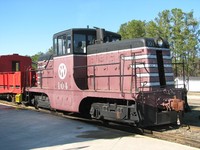Part 23: Interlude: GE 44TON(spbwf7)

44-Ton Switcher
Manufacturer: General Electric
Wheel Arrangement: B-B
Production Run: September 1940 – October 1956
Prime Mover: 4 Options
- Twin Caterpillar D17000 V8s (180hp each)
- Twin Hercules DFXD V6 engines
- Buda 6DH1742 V6 Engines (200hp each)
- Caterpillar D342 V6 engines
Total Produced: 386
Preserved: Lots, some still in revenue service
While the ALCo S1 is an end-cab switcher, the GE 44-tonner is one of the relatively few examples of a US designed center-cab switcher, intended for industrial and light switching duties.
This locomotive's specific 44-short ton weight was directly related to one of the efficiencies the new diesel locomotives offered compared to their steam counterparts: reduced labour intensity. In the 1940s, the steam to diesel transition was in its infancy in North America, and railroad unions were trying to protect the locomotive fireman jobs that were redundant with diesel units. One measure taken to this end was the 1937 so-called "90,000 Pound Rule" a stipulation that locomotives weighing 90,000 pounds (41,000 kg) – 45 short tons – or more required a fireman in addition to an engineer on common carrier railroads. Industrial and military railroads had no such stipulation. The 44-ton locomotive was born to skirt this requirement.
A special “Drop-Cab” military variant was created for use by the US Army Railroad in Europe. This variant featured a shortened cab to negotiate the more restrictive European clearances. This was accomplished by moving the compressed air system equipment from beneath the cab be adjacent to the engines.
source: wikipedia